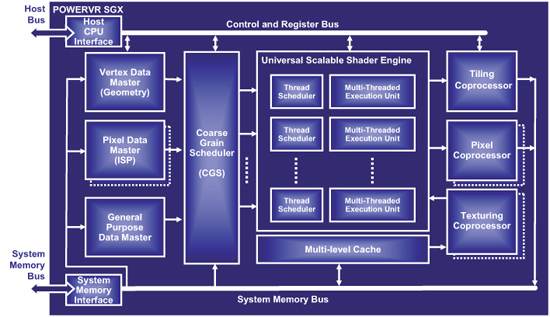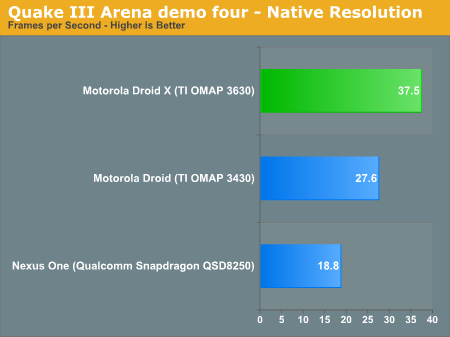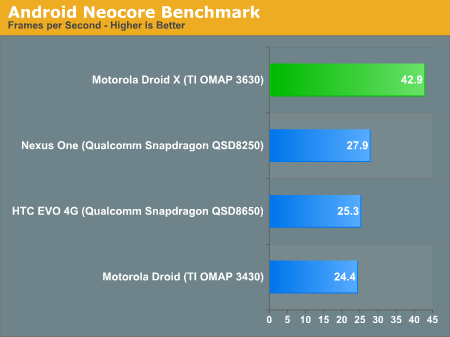Motorola Droid X: Thoroughly Reviewed
by Brian Klug on July 20, 2010 4:27 PM EST- Posted in
- Smartphones
- Motorola Droid X
- OMAP
- Mobile
The OMAP GPU - Powered by Imagination Technologies
TI continues to license its GPUs from Imagination Technologies. Rather than move to the PowerVR SGX 535 used by Apple and Intel, TI stuck with the same PowerVR SGX 530 core used in the OMAP 3430. The difference between the SGX 530 and 535 is as follows.
ImgTec refers to the execution hardware in its Series 5 GPUs as a Universal Scalable Shader Engine (USSE). Each USSE pipe can execute a 2-wide vector or up to a 4-way SIMD scalar op in a single clock. Both the SGX 530 and 535 have two USSE pipes from what I can tell.

The SGX 535 used in Apple’s A4 and Intel’s Atom Z600 series apparently have a second texturing unit and DirectX 9L support.
We’d expect that 3D apps on smartphones are more compute bound these days so it’s difficult to say how much you lose by going with the SGX 530 vs. 535. Until we get a Moorestown dev kit running Android we won’t be able to shed much light on that.
While the OMAP 3430 ran the GPU core at ~110MHz, the 3630 ramps it up to 200MHz. We’re seeing a lot of convergence around this 200MHz mark at 45nm. Intel runs the SGX 535 in Moorestown (Atom Z600 series) at 200MHz as well and I believe that’s what Apple uses in the A4 as well.
The 80% increase in GPU clock speed should result in significant real world GPU performance improvements. Just as with the CPU, there are no significant architectural changes to the GPU - it just runs faster.
The memory controller is still a 32-bit LPDDR1 interface, but can now run at up to 200MHz (the 3430 was limited to 166MHz). Should a customer choose to go for 200MHz LPDDR1 you’d get a 20% increase in memory bandwidth which will come in handy with the faster GPU in 3D apps for sure.
The GPU Performance Showdown: Snapdragon vs. OMAP 3630
When Brian first started cranking on the Droid X review he wanted to put the Qualcomm Adreno 200 vs. PowerVR SGX debate to rest. We had always reported that Qualcomm’s Snapdragon GPU was slower than the PowerVR SGX used in Apple’s A4 and TI’s OMAP 3, but we didn’t have a good idea of how much slower. Until now that is.
Armed with the Google Nexus One (Snapdragon QSD8250), Motorola Droid (OMAP 3430) and Motorola Droid X (OMAP 3630) all running Android 2.x (the N1 was running 2.2) we polished off one of the most popular GPU benchmarks of our time: Quake III Arena.
The kwaak3 project ported Q3A from a Nokia N900 version to Android. With a bit of elbow grease and getting around the lack of touchscreen keyboard support, we got the benchmark running. All scores were generated at default graphics quality settings and at native resolution, which unfortunately means the Droid X has around 7% more pixels to render than the other Android devices.

Even with the handicap, the 200MHz PowerVR SGX 530 core manages double the frame rate of the Adreno 200 in the Nexus One’s Snapdragon. Even the 110MHz SGX 530 is faster.
Here’s another interesting tidbit - we’re actually CPU bound on all of these platforms running demo four in Q3A:

Droid X (OMAP 3630) CPU utilization while running Quake III Arena
Intel is talking about greater than 100 fps frame rates with Atom Z600, meaning that the advantage is strictly on the CPU side. This also tells us that the PowerVR SGX 530 may even be a good fit for next year’s Cortex A9 based SoCs, even though TI has already committed to using the SGX 540 in its OMAP 4 line.
Neocore is another popular GPU benchmark, although this one is written for Qualcomm’s Adreno 200. The OpenGL ES 1.1 benchmark is mostly a GPU test but also stresses the platform as a whole. Running on our OMAP 3 based phones we see an average of 50% CPU utilization during the test.

The Droid X (OMAP 3630) CPU utilization while running Neocore
Interestingly enough, running the same test on a Snapdragon platform shows higher CPU utilization:

The Nexus One (Snapdragon) CPU utilization while running Neocore
The benchmark could be very well optimized for Qualcomm’s Scorpion core resulting in better CPU utilization compared to a Cortex A8.

The Adreno 200 in the Nexus One and EVO 4G outperforms the PowerVR SGX in the original Droid by 4 - 14%. This isn’t a surprise given the Qualcomm branding on the benchmark. The 45nm SGX 530 running at 200MHz puts all question to rest, the OMAP 3630 is 53% faster than Snapdragon.
The comparison here is obviously more than just GPU to GPU. We’re dealing with different CPU cores (ARM Cortex A8 vs. Qualcomm Scorpion), different memory controllers, different caches, and different drivers. Just as we’ve seen in the desktop GPU race, driver and benchmark optimizations have a lot to do with 3D performance results. I put more faith in the Quake 3 results, however those too came from a port optimized for PowerVR’s SGX.










89 Comments
View All Comments
jeffjcom - Wednesday, July 21, 2010 - link
Monoprice cables are Mini not Micro.MrPete123 - Wednesday, July 21, 2010 - link
A little bit off topic but....I haven't seen any mention of Android 2.2 and battery life. Do we know if executing code significantly faster allows the CPU to sleep more often, saving power? Or perhaps there's other power saving alterations in 2.2?bplewis24 - Wednesday, July 21, 2010 - link
I'm interested in this as well. Maybe update the Nexus One review with this info?Brandon
stlc8tr - Wednesday, July 21, 2010 - link
"It’s interesting that Motorola is sticking to FWVGA - this is admittedly exactly 16:9 aspect ratio"Well, I guess it depends on how digits of precision you're using. 854x480 is actually 16:8.992974. :-)
soydios - Wednesday, July 21, 2010 - link
Whichever author wrote that, you are not being too picky about the short 3-foot length of the included USB cable. 6 feet or bust. I'd say that the majority of us like to have the phone on the nightstand or desk while it's charging, not on the floor next to the power socket.Piano Man - Wednesday, July 21, 2010 - link
Now this is what I call a smartphone review. I'm glad that these smartphones are getting full review treatment like they were computer systems. Since I got my Moto Droid at work 7 months ago, I think about 25-30 more have followed suit. I really thing these phones are gonna become our primary all-in-one electronic system sooner than we think. Glad they're getting the review they deserve. Please keep it up for the future biggie's (Samsung Galaxy, and the new OMAP processors).jleach1 - Thursday, July 22, 2010 - link
"droid x lastest longest on a single charge"not sure if this was an accent -=D
dumpsterj - Thursday, July 22, 2010 - link
man i want this phone lol. I was gonna wait to see how windows phone 7 works out cuz i love zune . However it seems verizon is pissing all over microsoft lately with the kin and i wonder if vz will even get the damn phones.VashHT - Thursday, July 22, 2010 - link
Anyone else notice there evo benchmarks a lot better in this article than in the official evo review? It seems like the updates might have actually helped it out, it went from being slower to the incredible to faster in this review (in browsing tests I mean), you guys should update your evo review with the patches,i think they fixed the few little flaws the evo had when it first came out.One43637 - Thursday, July 22, 2010 - link
Great to hear Brian. I just picked up a Vibrant after owning a G1 for the duration. Phone is great, and I was pleasantly surprised how unobtrusive TouchWiz 3.0 is. Phone does not feel cheap at all, just because it has a plastic back.Can't wait to read your review and Froyo!